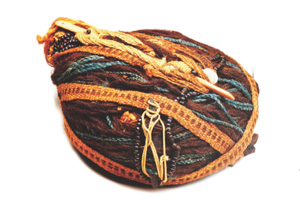In 1961, archaeologists were able to come to a consensus, and established a framework which divided the history of the first nations to inhabit Chile into different chronological periods. The term Paleo-Indian is used for the oldest period (as far back as 9000 B.C. approximately). This is followed by the Archaic period (between 9000 B.C. and 1500 B.C.), divided into early, middle and late stages. The Farmer-potter period was the last period, in which agriculture, commerce and the first villages arose. This period is also divided into early, middle and late stages and took in the period from 1500 B.C to 1470 A.D. With the arrival of the Spaniards, the Hispanic period began.
The Northern area
The Chinchorro Culture (6000 – 2000 B.C) developed on the northern coast of our country in the Archaic period. It populated the mouth of the Camarones River and its members were fishermen, hunters and seafood gatherers.
They were organised into small groups of between approximately 30 and 50 people, who seem to have been related to each other by marriage. Their main characteristic was their unique view of death, as they honoured their dead in a cult-like way and mummified them.
Later in the Farmer-potter period the San Pedro de Atacama culture began (500 B.C. – 1536 A.D.). It settled from the Loa River to the Atacama salt flat. The socio-economic organisation (ayllus) of the Atacama people was based on a group of families which, possibly, formed lineages. Each one had its own cemetery, with one hundred graves. Their ceramics were characterised by their preference for globular objects coloured in red and black, with necks and a flat base.
Under the influence of the Tiwanaku culture (central Andes), the Cabuza community (500 – 1000 A.D) arose between the western valleys of far north Chile and the south of Peru. The people of this culture lived in small villages and settlements spread around rivers.
Their houses were rectangular with stone foundations and walls of reeds and bulrush tied together with ropes, and were located near the crops. In metallurgy they worked with gold and silver, with which they made pendants and rings with figures of llamas.
Pica or «Pica – Taracapá» (900 – 1532 A.D.) was another northern people who lived in the Atacama Desert, between the Camiña Valley and the mouth of the Loa River. Their social organisation was a hierarchical lordship whose distinguishing feature was an authority which organised labour within a determined territory.
They dedicated themselves to rupestrian art, that is, paintings and engravings done on the rocky surface of a cave.
The Diaguita culture (900 – 1536 A.D.) flourished in the Norte Chico (Little North) region, from the Copiapó River (Region III) to the Choapa River (Region IV). It is said that its inhabitants were muscular, golden-skinned and long-haired, and that they customarily painted their faces with lines and black triangles. They dedicated themselves to agriculture, hunting, and raising camelids, although their main occupation was the production of pottery.
A direct descendant of the Cabuza culture, the pre-Columbian Arica culture (1000 – 1532 A.D.) was located from Mollendo in Peru to Taltal in Chile. They had a shamanistic religious system, reflected in the importance of instruments for inhaling psychoactive substances and drinking liquids which could alter the consciousness and produce hallucinations.
Central Chilean Cultures
In the early period, the Llolleo culture arose (300 – 800 A.D.), located between the Choapa (Region IV) and Cachpoal (Region VI) rivers. They did not form villages as each family maintained a certain distance from its neighbours. There were also, however, many places where only one family settled.
The Aconcagua people arose soon after (900 – 1536 A.D.). They belonged to the late Farmer-potter stage. The main area in which they settled was the basin of the Maipo and Mapocho Rivers (Metropolitan Region) and they mainly dedicated themselves to hunting.
Southern Villages
In the south of the country the Pitrén culture (600 – 1532 A.D.) began. It was the first horticultural (the cultivation of maize and beans) culture to settled between the Biobio River (Region VII) and the northern shore of Lake Llanquihue (Region X).
However, horticulture was not its main sustenance, but rather the gathering of forest fruits (pine nuts) and the hunting of guanaco and deer. Its pottery, especially its animal-shaped jars, is recognised as the oldest in the area. Their houses were built in small spaces in forest clearings, although they continuously moved from place to place.
Finally we find the El Vergel community (1000 – 1500 A.D.), which was mainly based between the Itata (Region VII) and Toltén (Region IX) rivers. They did not form villages and their economy was mainly agricultural. They buried their dead in ceramic urns, painted in black and white.








 Muere Evita
Muere Evita